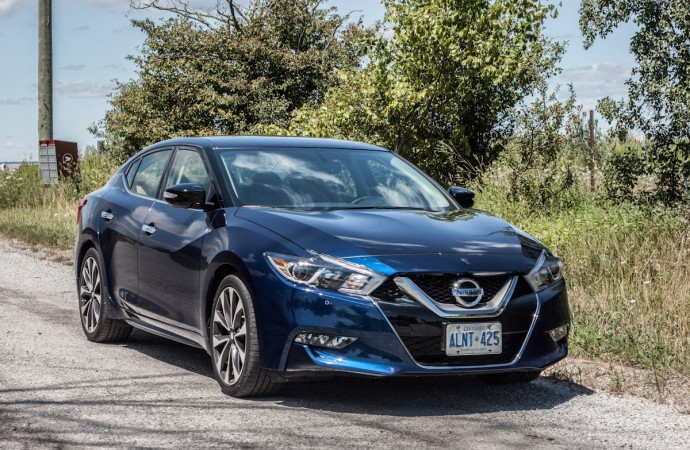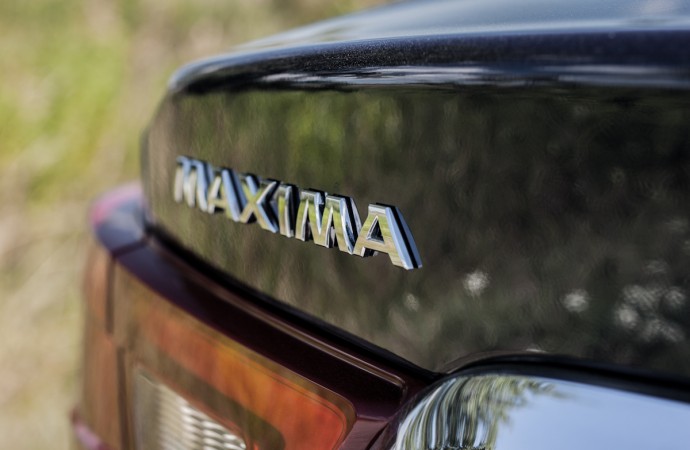Having not seen a significant redesign since the 2009 model year, the Nissan Maxima has been soldiering on with some dated architecture for the past couple of years. Regardless, I was still a fan of the styling and more importantly, the powertrain. You see, I still own a 2002 Maxima SE with the six-speed manual, the first year the VQ 3.5L motor was offered. To this day, it’s my “leave-behind” vehicle that spends weeks on end at various manufacturers’ offices while I drive test vehicles. Therefore, ever since I first laid eyes on the all-new model, I was nagging my editor to assign me the vehicle. I will be the first to admit that before picking up this 2016 Nissan Maxima SR, I spent one sleepless night anticipating the car.
Nissan’s engineers have clearly thought this one out well; the redesigned Maxima has been thoroughly reworked from every possible angle, both inside and out, to ensure that it is indeed all new. The exterior has been elongated by 5.6cm and the overall height has been cut by 3.3cm to further suit its sporty image. The Nissan “floating roof” design and slick styling goes a long way to make it the most polarizing sedan in its segment. Of course, with comfortable and conservative choices in the class like the Toyota Avalon and Hyundai Genesis, the new Maxima is easily the go-to choice for those looking for something that’s not cookie-cutter.
A chrome-accented open mouth grille and LED daytime-running lights highlight the front end nicely. The side profile is different from everything else too, with its swooped roofline and taillights that wrap right onto the side of the car. I prefer the rear end’s slightly more elegant styling, and this was only confirmed by some onlookers’ reactions to the front of the Maxima as “trying too hard”. Regardless, this is a seriously good-looking car and I predict it will age much better than its predecessors.
All trim levels of Maxima are powered by the 3.5L VQ V6, completely re-engineered for this new car and featuring 60 percent new components. Nissan insists that this motor feels completely different from that of the outgoing model, and my driving impressions mostly confirmed this. The 3.5L pushes out 300 horsepower at 6,400RPM and 261 lb-ft of torque at 4,400RPM. Rowing your own gears hasn’t been an option for a while now, as the sole transmission choice is a sport-tuned continuously variable transmission (CVT). My criticisms of CVTs are beginning to fade into the forgotten past, because the two manufacturers that insist on using them throughout the lineup (Nissan and now Subaru) have done a brilliant job of perfecting the application.
The Maxima’s V6 is responsive and still makes that throaty roar at higher RPMs that the VQ-series engines are known for. Even in “Normal” mode, the car has ample power and the transmission is responsive. When put into “Sport”, the car once dubbed the “4-door sports car” feels boldly athletic as throttle response becomes sharper, and the transmission simulates 7 “gears”. The paddle shifters are a nice touch, especially because they’re fitted to the steering column rather than the wheel, fixing their position permanently.
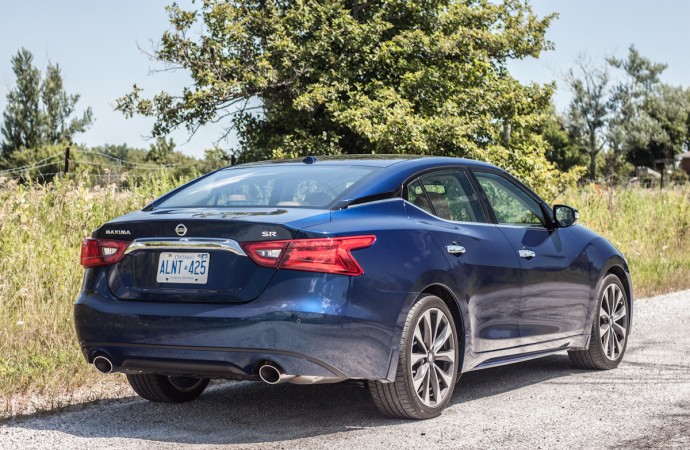
What’s really remarkable here is the 2016 Nissan Maxima’s chassis. It’s been lightened and stiffened, with a 25% overall increase of torsional rigidity. The result is a big sedan that actually presents a good case for itself with regard to driving dynamics. This is the sport-oriented SR with sport-tuned suspension that helps even more, along with Active Ride Control and even a deleted sunroof for minimal floppiness. The IDM (Integrated Dynamic-Control Module) is an electronic gizmo that deals with chassis management behind the scenes. The Maxima’s steering is on the heavy side and feels a little bit like a video game in city driving, but the tightness is great for both highway runs as well as leisurely drives through the countryside.
Nissan has rated the new Maxima at 10.9L/100km city and 7.8L/100km highway, for a combined 9.5L/100km. This is an overall 15% improvement from the outgoing model. Even with well over 250,000km on the odometer, my 2002 with the stick shift still returns 8.5L/100km on 91-octane, so I was eager to see how the latest one behaves with all of the new technology packed into it. After about 500km worth of combined driving over my test week, I managed 8.9L/100km on premium fuel, not bad in the slightest when you consider how much weight the car has inevitably put on (thanks to the added safety features, tech, and luxury) in the 14-year gap between the two models.
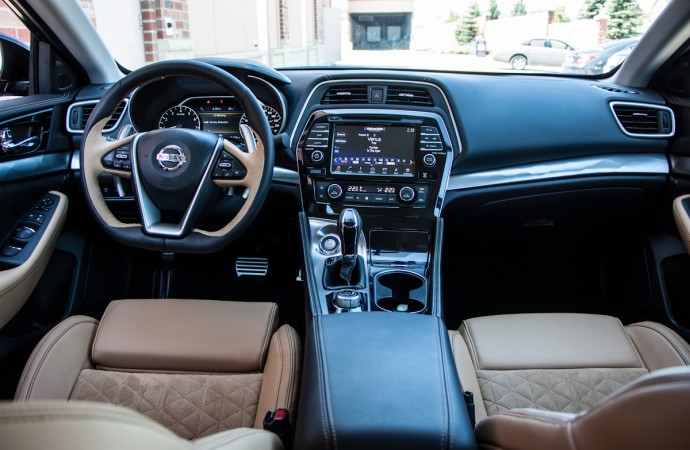
The huge conversation piece with the new Maxima is the class-leading interior. Even in this sport-oriented SR model, the passenger cabin offers things that cars with much higher sticker prices don’t. Fit and finish is outstanding, and all materials look and feel very high quality. The seats are finished in both leather and Alcantara, and there’s diamond-shaped quilting that looks straight out of something from Bentley or Rolls-Royce. The door panels have Alcantara inserts and the brushed metal used on the dashboard has stunning patterning throughout. The steering wheel (flat-bottomed, by the way) has faux-suede within it that reminds you that this is a premium offering. Also notable is the entire center stack that has been tilted seven degrees towards the driver, much like in the GT-R
Adding to the Maxima’s base price of $35,900, this sporty SR trim level goes up to $41,100 before incentives. This includes everything standard on the base SV and adds 19” diamond-cut and machine-finished alloy wheels, LED headlights, the previously-mentioned sporty bits on the chassis and suspension, the quilted seats with Alcantara, There’s also a Bose premium sound system with 11-speakers, an 8.0” touchscreen with multi-touch control, heated and ventilated seats, a 7” colour display within the instrument cluster that controls settings and other drive functions, and countless other features that make the car a great place to spend hours on end.
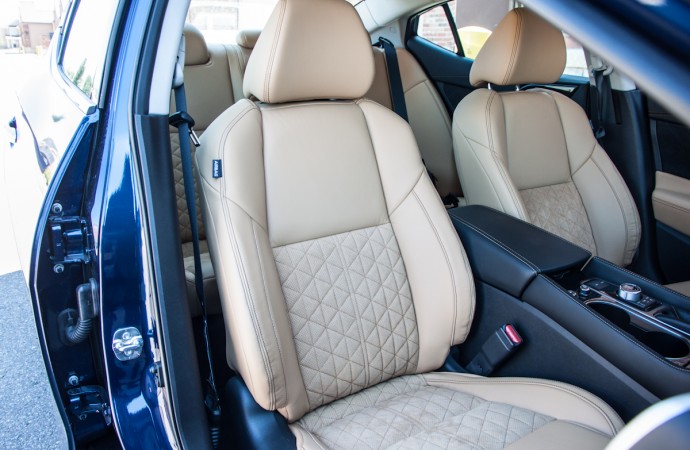
I had big problems with the infotainment setup on the previous model, and they have been worked out with the new model. There’s a rotary controller perfectly positioned that controls everything, and I was particularly surprised to see that the new NissanConnect system is able to retrieve local fuel prices, weather, and other useful bits via SiriusXM satellite. The Maxima connects seamlessly to the cloud for traffic updates, and the revised navigation system works beautifully. My only real wish for the car is the availability of all-wheel-drive as an added option. This would poach some sales from the Dodge Charger, Chrysler 300, and Ford Taurus, all of which are huge players in this segment.
Canadians bought just over a thousand new Maximas in 2014, and I’d like to chalk this off to the outgoing model being dated and there being some heavy competition out there, especially with the new Genesis and Avalon. I think that this bold redesign will go a long way to helping sales and revitalize the Maxima’s image. After all, this was one of the most popular big sedans many years ago, and it’s not uncommon to still see decade-old models driving around in great shape. The 2016 Nissan Maxima SR is a sporty yet luxurious choice in the full-size sedan segment. Despite not offering rear or all-wheel-drive, it’s a car that offers smart packaging, good looks, and a plush interior for a relatively affordable price.


















